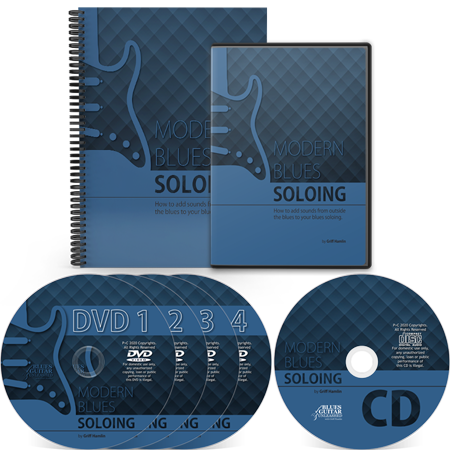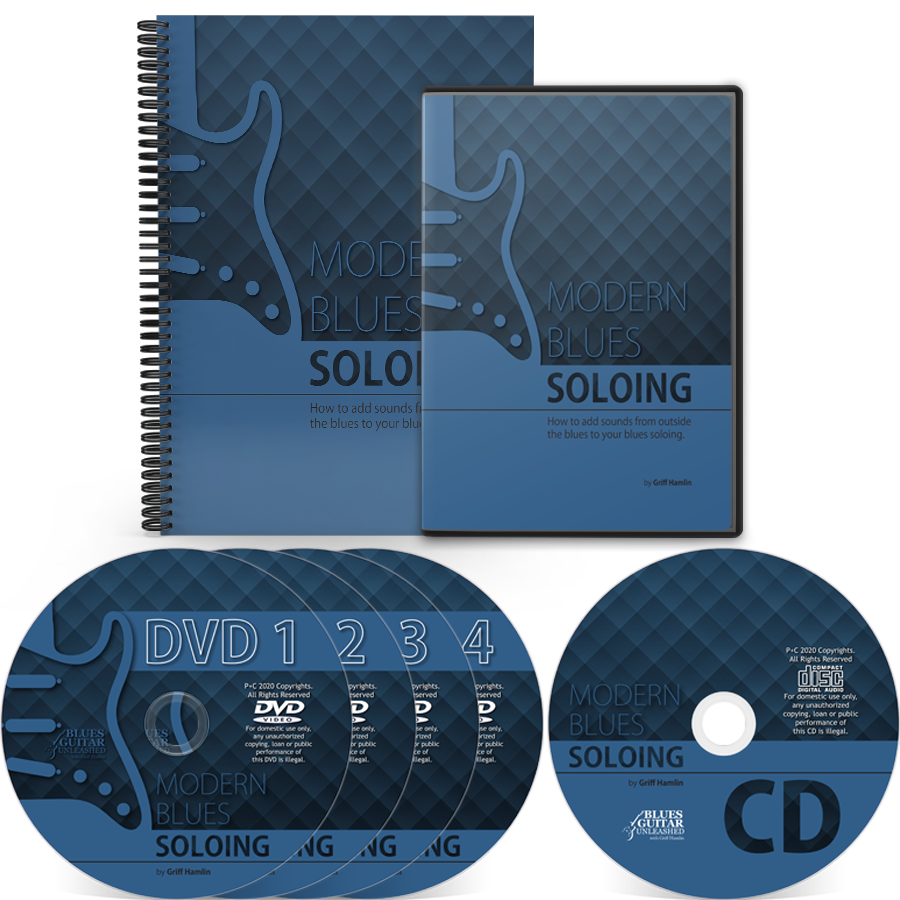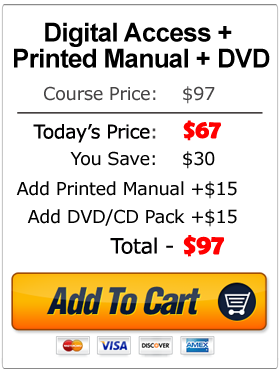- Days
- Hours
- Minutes
- Seconds
Special Launch Week Pricing In Effect...
Video Series Reveals How To Weave Sophisticated Modern Blues Solos Using Traditional Blues And Jazz Elements…
…Without Requiring A Music Degree Or Years Of Training And Transcribing
If you’ve ever been fascinated and mystified by the cool, modern sounds of blues players like Robben Ford, Matt Schofield, Josh Smith, Larry Carlton, Scott Henderson, and many others… then you are in for a real treat…
Most folks, myself included, have spent many years hearing those sounds, but always wondering where they came from...
Or, maybe you've even read through some TABs or you've figured out what the notes are... but that doesn't tell you much because they just don't seem to make much sense.
I'm happy to tell you that there is a method to the madness, and I've figured out how to break it down into pieces that make sense and sound really cool.
But Let’s Be Clear…
This may not be a sound you are into… and if you’re a brand new guitar player, this isn’t going to be for you…
Similarly, if you’re looking for the magic pill, nothing works that way. Like anything you learn, this is going to take some time, and maybe a little experimenting for yourself.
Because these sounds aren’t like what you’ve played in the past, if all you’ve played is traditional blues.
In fact, the entire “Every Chord Is 1” approach may be completely foreign and new to you.
But, if you’re already comfortable with a few things like:
- The 12 Bar Blues Form
- How to play most blues chords (7th, 7#9, 9th, etc.)
- The Pentatonic Major And Pentatonic Minor Scales (preferably with “The Blue Note” as well)
… and you want to raise your level of sophistication about 10 levels…
… and you’re willing to practice at least 20-30 minutes per day (ok, maybe not every day, but at least 4 or 5 days a week)…
… then I can, most definitely, show you how these sounds work, where they come from, and how you can create them on your own so you can make up your own new sounds and use them in your own solos.
Now then, if you’re still with me, let me show you…
Exactly What You’re Getting
 Modern Blues Soloing is a complete video course, a little over 7 hours long (maybe 8… who’s counting?) plus a written manual with similar explanation to the video, and complete transcriptions of every example throughout the course.
Modern Blues Soloing is a complete video course, a little over 7 hours long (maybe 8… who’s counting?) plus a written manual with similar explanation to the video, and complete transcriptions of every example throughout the course.
It’s all about bringing in modal sounds, jazz elements, and synthetic outside sounds to your blues soloing.
So if you’ve ever heard a Matt Schofield or Robben Ford solo and kind of turned your ear and thought, “What was that? I’m not sure that’s blues, but it sure is cool!”
… then this is totally for you.
When I was in my early 20s (let’s not talk about how long ago that was…) and I first heard this type of playing I was, quite literally, blown away…
I’d simply never heard anything like it, and I began to try and transcribe solos from Robben Ford, Scott Henderson, Larry Carlton, and many others…
The problem was, they were all just notes on a page. I could figure out what they were playing… but I could never figure out why!
The why, as it turned out, was going to take another decade or so 🙁
In fact, it wasn’t until I finally studied a whole lot of jazz stuff in my late 20s and early 30s that I finally started to piece it all together…
And from there, it took me another 10 years to figure out how to teach it so that my students didn’t need a degree in jazz to understand it!
But now it’s done, and you can benefit from those last 20 years or so, today (yay!)
What’s super cool is that…
It’s WAY More Than Just Playing “Weird” Stuff…
Sure, you can tweak your poor listener’s ear into oblivion… and I’ll show you how to bring them back from the brink of threatening to walk out of the room if you don’t resolve something quick…
But most of us aren’t super into that (I am into that… but I know that I’m not normal…)
However, the “Every Chord Is 1” approach means that you are laser focused on every single chord tone of every single chord…
Even if you never play a single “outside” sound, you’re still going to sound way more effective because you are implying the chord progression better.
When you use the traditional pentatonic scales, they are basically a “not wrong” option…
In other words, the notes in the pentatonic scales sound fine for all 3 chords in a blues – they aren’t perfect for any one of the chords, but they work for all 3 so we leave it alone.
And, truth be told, that’s the sound of traditional blues and I would never suggest that you quit playing those sounds…
But when you hear a brilliant soloing like Matt Schofield or Robben Ford, you can tell that there is a lot more going on…
Sure, it still sounds like blues, but the level of sophistication is just so much higher… it’s like they take you on a little vacation through the chords, they don’t just play a bunch of licks on top of the chords.
And hitting all of those “right” notes around the chord changes takes more than your pentatonic and blues scales can do.
Even something as simple as a minor blues (like, “The Thrill Is Gone”) can benefit from a sound called the Lydian Dominant scale… it’s just one note different from your regular Mixolydian Mode (which, if you know the major and minor blues scale, you already know, even if you don’t know that you know… you know?)
In fact, here’s just a fraction of what you’re getting in the course…
- How to play your major and minor pentatonic/blues sounds together, to create “subgroups” of notes that are far more effective than either scale can achieve on its own.
- When to use chromatic notes and why (and why not!)
- How to use the Dorian Mode for a more aggressive minor blues sound and more note choices.
- Why the Mixolydian and Dorian Mode are so similar to the pentatonic scales you already know. So if you don’t already know the modes, they are super easy to add to your vocabulary.
- How the modes work in parallel so that one scale pattern works for more than one mode.
- How to use the half-whole diminished scale when you want step just a little outside, but not a lot.
- Why creating tension, and releasing that tension, is the most important musical concept when deciding on the use of outside or modal sounds.
- How the diminished arpeggio works from the half-whole diminished scale.
- How a simple “hack” of realizing the diminished sound repeats every 3 frets makes it dead simple to play it all over the neck almost immediately.
- The “inside” use of the Lydian Dominant scale in a minor blues (over that bVI chord in the turnaround.) Sure, you can keep using the minor blues scale, but this sounds way hipper!
- The secret trick of the “flat-five substitution” that allows you to look at the same set of notes 2 different ways, depending on what works best for you. That way, you’ll easily be able to see it on your fretboard when you need it.
- All the sounds that are also used in jazz music. Let’s face it, if you ever wanted to play jazz, these are the sounds all the “hip” jazz players are using too. You would not need to learn any new scales or patterns.
- How to “encase” a target note to make your lines flow and sound more melodic. Blues licks are cool, and can sound great… but it takes a bit of jazz know-how to create truly melodic phrases that both outline the chords and can handle tension and release.
- You’ll see how to combine a simple scale, with a little chromatic movement (chromatic means using every note, even the ones not in the scale), and an arpeggio to make a simple descending line take on a life of its own (this took me YEARS to get down, and I’ll show you in a few minutes!)
And while that’s a whole lot of cool stuff… you’re also getting
6 Complete Note-For-Note Solos
It’s one thing for me to tell you how all of this works, and another thing entirely for you to actually play it and use it and feel it for yourself.
So in addition to all of the scales, all of the licks and examples contained in the first several lessons, there are 6 complete solos in a variety of styles:
1. The Shuffle In A – Blues is all about the swing/shuffle feel so this 24 bar (2 chorus) solo is perfect for getting your feet wet and showing you how these sounds can be effective in a traditional blues context.
2. The Funky Cajun Blues In A – While staying in the key of A, we’re going to change up the feel quite a bit on this solo…
It took me many years to realize that one of the biggest differences between the traditional blues I listened to, and the modern blues, was the feel. Often the chords would be standard (or close to it) but the feel would be more “funky” and would lend itself to different sounds, because of that difference in feel.
3. A Funky Blues In D – Freddie King has always been a big influence on me, and his song, “Me And My Guitar,” is one of my favorites. It has a great feel, a little funky, but still definitely blues.
Because of that funky feel and the slower tempo, it really lends itself to some fun ear-bending sounds.
4. The Slow Blues In G – What would blues be without the classic slow blues? Well, this ain’t quite that…
The slow blues, because of it’s slower tempo, gives us some prime places to imply some altered chords… and if your band is on the ball (and, in this case, they are) they might even hear what you’re laying down and join you!
So listen as much to the chords as you listen to the sweet melodies in this next one.
5. The G Minor Straight Feel Blues – Starting with solo 5, we venture beyond the 12 bar blues framework because a lot of modern blues does just that.
In this case, we’ll make more use the Lydian Dominant sound over the characteristic bVI chord used in so many classic, minor blues tunes.
6. The D Minor Rock/Blues/Jazz Tune – Going as far as we’ll go away from Blues and getting more towards Rock, with a touch of the jazz, this last solo is as epic as the song I borrowed it from…
Originally done by BB King (at least, that’s the oldest recording I’ve heard), “Help The Poor” was cut by Robben Ford on his album, “Talk To Your Daughter” in 1988.
It’s always been one of my favorite songs to play over, and the chords in this track and solo example are heavily influenced by that ground-breaking recording. This one really runs the gamut from traditional blues to all out rock-inspired jazz fusion.
In every single solo I’ll break them down, note for note and lick for lick. I’ll show you not only the notes, but that always important – why.
Plus, in every instance where it’s possible, I’ll give you 2, 3, maybe even 4 different ways to look at a lick. It doesn’t matter which one you pick – it just matters that it works for you.
But once you learn these new ideas, you’re going to want to try them out for yourself (and you should, because some healthy experimentation goes a long way)…
So I’m also including…
6 Full Length Jam Tracks in the same styles, tempos, and feels as the solo examples.
Once you learn a lick or an idea, it takes a little time to let your brain know that this is something you’re going to need to remember for a good long time.
And the way you do that is by using the lick (what a concept!)
So here’s what you do…
When you learn one of the licks that you really like, play it until you have it memorized…
Then switch over to the jam track and keep trying to play that lick and fit it in with the jam track.
At first, it may be a little tricky, but that’s ok, just try for a couple of passes, then come back tomorrow.
In my experience, it takes about 3 solid sessions with a lick before it really becomes part of your vocabulary.
The jam tracks are a solid 4 minutes long or more, and you’ll have plenty of opportunities to use the lick each pass through the track.
Make sense? Good…
Now, Here’s What To Do Next…
As I said, Modern Blues Soloing consists of 7+ hours of video, a manual with all the TAB and explanations in it, and play-along tracks for each of the solos (slow and full speed, plus one with no guitar) and the 6 full length jam tracks.
It’s all immediately available in your secure member area after you complete your purchase.
The online players allow you to slow down and repeat portions or all of the videos, plus you can quickly access individual examples using the navigation on the side of the player.
As you can see from the examples above, the TAB is on-screen, but if you prefer to use the manual, it’s all in there too. (I like to print out the song I’m working on and keep it on my desk while I watch the video, and then keep it handy as reference while I practice.)
The videos are in full HD quality – considerably better than a DVD, and will look great even on a big 30, 40, or 50 inch screen.
You can also download the videos to your local computer, phone, tablet, whatever, if your device will handle that. You can download the manual and the audio tracks too.
But if you prefer having it on DVD, or prefer having the manual printed, there are options for that too. Regardless, you’ll still get the digital version so you can get started right away even if you need to wait for the DVDs to arrive.
It costs just $97, even though I have dozens of private students who have paid thousands of dollars to get this information (and I didn’t even have the jam tracks for them!)
But, right now, since this is the first week of release, you can get it for just $67!
And, as always, you are completely covered for a full 90 days by my absolute no-questions-asked guarantee…

If you don’t absolutely love Modern Blues Soloing with 90 days, just let my friendly helpdesk know and you’ll get a full and complete refund, no questions asked.
And you don’t even have to send it back.
So, Are You Ready?
I know it’s easy to look at something like this and think, “Man, that’s really cool, some day I’d love to be able to do that.”
But then, you watch another YouTube video or start on a new song and pretty soon a year has gone by and you’re right where you were last year…
Don’t let it get away from you this time… grab your copy of Modern Blues Soloing and within just a few minutes (before you get sidetracked) you can be on your way to some really cool, new, exciting sounds in your blues playing.
And the next time you get to play at a jam session or get together, won’t it be nice to have people actually notice you are playing something different? And something better and more interesting?
Just choose your delivery method below and let’s get started, shall we?
Head’s Up!!!
![]() If you choose the DVDs or the Printed Manual option below, please know that I have not ordered them yet and you are pre-ordering them now…
If you choose the DVDs or the Printed Manual option below, please know that I have not ordered them yet and you are pre-ordering them now…
Of course, you’ll still have immediate access to the digital materials, but until I know how many to order, I don’t want to run out. So expect about an extra 10-14 days on the DVDs and Manuals to arrive.
To get your complete copy of Modern Blues Soloing just click the yellow “Add To Cart” button below with your preferred delivery method. Just as soon as your order is complete you will receive an email with your access instructions to the secure Member Portal so you can be creating exciting new blues solos in just a few minutes from now!

This is a one time payment, NOT a subscription. 3 Payment option is available on the next page.
Now, in case you’ve scrolled to the bottom (or you just want to see what I wrote here) let me give you the “Cliff Notes” version…
I’ve got this cool new course called Modern Blues Soloing that will show you all the ins and outs of how to play that cool modern blues stuff guys like Matt Schofield, Robben Ford, and Josh Smith play…
It’s 7+ hours of video, a bunch of cool audio tracks to play with, and a complete manual with all the TAB and explanations (but, use the video first and foremost.)
It’s just $67 during this special first week of release, and also comes with 6 complete solo examples, completely broken down note-for-note and I’ll explain the why behind every single lick.
And if you want it on DVD or the manual printed out, I can do that too, just choose the option that suits you best.
As always, it’s covered by my 90 day, bulletproof guarantee – you love it or I give you a refund, no questions asked and you don’t have to send it back.
Got it? Good.


